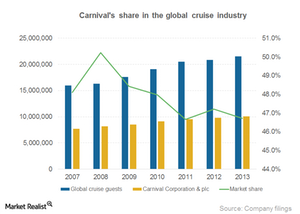Carnival boasts largest market share of cruise passengers
The number of Carnival’s cruise passengers has increased at a six-year CAGR of 4.6%. It has the largest market share of cruise passengers at ~47%.
Jan. 14 2015, Updated 10:37 a.m. ET

Growth in cruising industry
The global cruising industry has grown over the years, driven mainly by the North American and European markets. The growth rate of the cruising industry has exceeded the growth in land-based tourism over the past ten years.
According to Cruise Lines International Association (or CLIA), between 2003 and 2013, 5% of global tourists arrived at their destinations by water, cruise, and ferry. While land-based tourism has increased by 57%, demand for cruising has increased by 77%.
The number of cruise guests has increased at a six-year compounded annual growth rate (or CAGR) of 5%, to ~22 million in 2013. The number of Carnival Corporation and plc’s cruise passengers increased at a six-year CAGR of 4.6% between 2007 and 2013, close to the global industry’s growth of 5%.
Major players in the cruise industry
The three major cruise liners that account for more than 80% of the global passengers include Carnival Corporation (CCL), Royal Caribbean Cruises Ltd. (RCL), and Norwegian Cruise Line Holdings Ltd. (NCLH). Carnival Corporation is the largest with a market share of cruise passengers at ~47%, followed by Royal Caribbean at ~23% and Norwegian at ~10%. However, Carnival’s competitive advantage is due to scale. It operates a fleet of 101 ships, which is more than double the 41 ships operated by Royal Caribbean, its closest competitor.
ETFs such as the PowerShares Dynamic Leisure and Entertainment Portfolio (PEJ), the PowerShares Dynamic Large Cap Growth Portfolio (PWB), and the Consumer Discretionary Select Sector SPDR Fund (XLY) hold stocks of the three major cruise liners.
The other smaller players in the industry include MSC Cruises, Disney Cruise Line, and Thomson Cruises. As you can see in the above chart, Carnival Corporation’s (CCL) market share has declined from 50% in 2008 to 47% in 2013.
